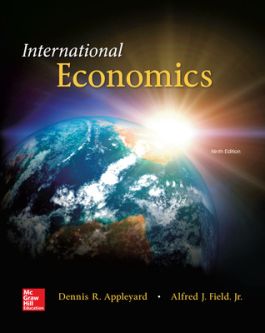International Economics
CHAPTER 1
The World of International Economics,
PART 1 THE CLASSICAL THEORY OF TRADE
CHAPTER 2
Early Trade Theories: Mercantilism and the Transition to the Classical World of David Ricardo
CHAPTER 3
The Classical World of David Ricardo and Comparative Advantage
CHAPTER 4
Extensions and Tests of the Classical Model of Trade
PART 2 NEOCLASSICAL TRADE THEORY
CHAPTER 5
Introduction to Neoclassical Trade Theory: Tools to Be Employed,
CHAPTER 6
Gains from Trade in Neoclassical Theory
CHAPTER 7
Offer Curves and the Terms of Trade
CHAPTER 8
The Basis for Trade: Factor Endowments and the Heckscher-Ohlin Model
CHAPTER 9
Empirical Tests of the Factor Endowments Approach
PART 3 ADDITIONAL THEORIES AND EXTENSIONS
CHAPTER 10
Post–Heckscher-Ohlin Theories of Trade and Intra-Industry Trade
CHAPTER 11
Economic Growth and International Trade
CHAPTER 12
International Factor Movements
PART 4 TRADE POLICY
CHAPTER 13
The Instruments of Trade Policy
CHAPTER 14
The Impact of Trade Policies
CHAPTER 15
Arguments for Interventionist Trade Policies
CHAPTER 16
Political Economy and U.S. Trade Policy
CHAPTER 17
Economic Integration
CHAPTER 18
International Trade and the Developing Countries
PART 5 FUNDAMENTALS OF INTERNATIONAL MONETARY ECONOMICS
CHAPTER 19
The Balance-of-Payments Accounts
CHAPTER 20
The Foreign Exchange Market
CHAPTER 21
International Financial Markets and Instruments: An Introduction
CHAPTER 22
The Monetary and Portfolio Balance Approaches to External Balance
CHAPTER 23
Price Adjustments and Balance-of-Payments Disequilibrium
CHAPTER 24
National Income and the Current Account
PART 6 MACROECONOMIC POLICY IN THE OPEN ECONOMY
CHAPTER 25
Economic Policy in the Open Economy under Fixed Exchange Rates
CHAPTER 26
Economic Policy in the Open Economy under Flexible Exchange Rates
CHAPTER 27
Prices and Output in the Open Economy: Aggregate Supply and Demand
PART 7 ISSUES IN WORLD MONETARY ARRANGEMENTS
CHAPTER 28
Fixed or Flexible Exchange Rates?
CHAPTER 29
The International Monetary System: Past, Present, and Future
McGraw-Hill Connect is an award-winning digital teaching and learning solution that empowers students to achieve better outcomes and enables instructors to improve course management efficiency.
High-Quality Course Material
Our trusted solutions are designed to help students actively engage in course content and develop critical higher-level thinking skills while offering you the flexibility to tailor your course to the ways you teach and the ways your students learn.
Assignments & Automatic Grading
Connect features a question bank that you can select from to create homework, practice tests and quizzes. Dramatically reduce the amount of time you spend reviewing homework and grading quizzes, freeing up your valuable time to spend on teaching.
Analytics & Reporting
Monitor progress and improve focus with Connect’s visual and actionable dashboards. Reports are available to empower both instructors and students with real-time performance analytics.
Seamless Integration
Link your Learning Management with Connect for single sign-on and gradebook synchronization, with all-in-one ease for you and your students.


